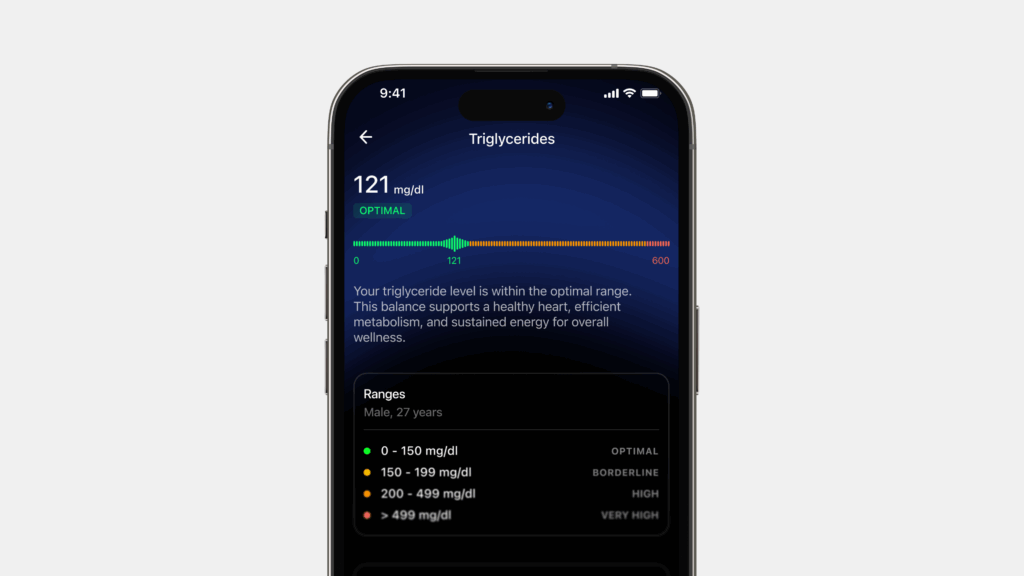Metabolism is the process by which the body converts all the food and drinks you consume into energy.
Metabolic health, on the other hand, is described as having ideal levels of blood sugar, triglycerides, high-density lipoprotein (HDL) cholesterol, blood pressure, and waist circumference, without using medication.
Gaining a perspective on your well-being through the lens of metabolic health makes for a sustainable approach.
One of the easiest methods of measuring your metabolic health is by calculating your metabolic score through the CGM device.
Essential read: Metabolic age explained and how to reduce it
Highlights
- Metabolic score is a daily rating (0–100) based on your blood glucose patterns.
- It reflects overall metabolic health and is calculated using three factors: glucose variability, average glucose, and time in target range (70–110 mg/dL).
- Consistent lifestyle changes—like walking after meals, improving sleep, and eating to reduce glucose spikes—can help improve your metabolic score.
What is a metabolic score?

Metabolic score is the overall rating given to your daily blood sugar pattern. It is an indicator of your overall metabolic health and depends on three factors – glucose variability, average glucose and time in target score.
The metabolic score ranges from 0 to 100, and it resets itself every midnight to 100. Based on your lifestyle – food and beverages consumed, daily activities, stress levels, quality of sleep and your body’s unique response, the score increases or decreases daily. The goal is to maximise this score every day.
How is a metabolic score calculated?
This Metabolic score is calculated with the help of three metrics:
Glucose Variability
Glucose levels oscillate throughout the day. At any given point in time, if you measure your glucose levels, you’ll notice the variations transpiring through the course of the day. These spikes and drops in the glucose graph represent your glucose variability.
Glucose variability reflected on the Ultrahuman app is the coefficient of variability, calculated by dividing the standard glucose deviation value by the mean glucose value multiplied by 100 to obtain a percentage. The glucose variability is a sign of the spread in glucose readings around the average.
For example, if there are many highs and lows on any given day in your glucose readings, the standard glucose deviation will be higher too, indicating higher glucose variability. On the other hand, if you have a relatively stable glucose level, you will have a lower standard glucose deviation, indicating lower glucose variability.
Therefore, a low glucose variability demonstrates that you have a stable glucose trend, which indicates good metabolic health. A high glucose variability, on the other hand, implies that your body is subjected to constant spikes and crashes of glucose which could render you feeling lethargic, especially after a high carbohydrate meal.
Eating a balanced diet, getting quality sleep, and reducing overall stress can lead to a relatively stable glucose curve without many spikes and crashes. Less than 12% is the ideal range and will result in a better metabolic score.
Average Glucose
To understand average glucose we first need to understand the role glucose plays in the blood. Hemoglobin carries oxygen in the red blood cells.
Glucose attaches itself to the haemoglobin and forms a unit called glycated haemoglobin or glycosylated haemoglobin. Since red blood cells live for an average of 3 months, glycated haemoglobin reflects sugar exposure to the cells over a similar time range.
When your blood glucose is high, the percentage of hemoglobin molecules latching onto glucose is high as well. This means that this measure changes gradually as the red blood cells die and are replaced by new cells. Traditionally, doctors used HbA1c tests to determine average glucose over a period of 2-3 months.
According to the American Diabetes Association, the HbA1c ranges are:
HbA1c Ranges According to the American Diabetes Association
- 4.0% to 5.6% – Normal range
Indicates healthy blood glucose control. - 5.7% to 6.4% – Prediabetes
Elevated risk of developing type 2 diabetes. Lifestyle changes and medical guidance are recommended. - 6.5% or higher – Diabetes
Diagnostic of diabetes. Requires medical evaluation and long-term management.
At Ultrahuman, we use average glucose data points to calculate your estimated HbA1c.
How Ultrahuman measures average glucose
The Continuous Glucose Monitoring (CGM) device used by Ultrahuman measures the glucose value of the interstitial fluid. The average glucose is calculated from all the glucose points in that given day.
So, if you check your glucose levels at 5 PM, your glucose levels will be the average of all glucose points from 12 AM of that day to 5 PM of the same day. This is a much faster method of measuring the average glucose levels in real-time. An average glucose range of 70-100 mg/dL is considered ideal.
Lack of sufficient sleep, increased stress, infections in the body, lack of exercise and insufficient rest post working out can lead to a high average glucose level. Regularly exercising and eating food eliciting a lower glycemic response can help you stabilise your average glucose levels and improve your metabolic score.

Time in Target score
Time in Target score is a metric that measures the time during which the blood glucose is in the target range. The ideal target range for glucose is 70-110 mg/dL. Having your glucose levels within this range throughout the day will help you maximise your metabolic score. This metric is measured as a percentage. A higher percentage is indicative of better metabolic health.
If your glucose exceeds the target range, taking a walk will help lower your glucose levels. If your glucose falls below the normal range, having a light snack will help bring it back up.
Time in target score is an important metric to include because it accounts for hypoglycemia (low blood sugar levels). The HbA1c test does not account for hypoglycaemia, and therefore, time in target remains an important metric in measuring your metabolic score.
Why it matters
- Cardiovascular benefits: Better blood pressure, improved circulation, healthier cholesterol levels
- Glucose control: More stable blood sugar and lower risk of insulin resistance
- Reduced inflammation: Lower risk of chronic pain and inflammatory conditions
- Improved hormonal health: Enhanced fertility, sexual health, and mood stability
- Better body composition: Increased muscle mass, improved bone density, healthier weight
- Brain and immune support: Improved cognitive resilience and a stronger immune system
- Lower risk of chronic disease: Less risk of type 2 diabetes, obesity, stroke, and Alzheimer’s
Also read: How Ultrahuman M1 calculates metabolic score
How to improve your metabolic score
How To Improve Your Metabolic Score
Your metabolic score reflects key aspects of glucose control—like stability, average levels, and time spent in a healthy range. To improve it, focus on habits that support metabolic flexibility and reduce glucose volatility:
- Walk after meals and exercise: A 10–15 minute walk can blunt post-meal glucose spikes by increasing glucose uptake in muscles. Both cardio and resistance training improve insulin sensitivity and help maintain lower baseline glucose levels.
- Eat for stable glucose: Prioritize whole foods, fiber, protein, and healthy fats. Avoid refined carbs and ultra-processed snacks that cause sharp spikes.
- Manage stress: Chronic stress elevates cortisol, which can drive up blood glucose independent of diet. Practices like breathwork, meditation, or even cold exposure may help.
- Sleep consistently: Poor or irregular sleep increases insulin resistance and reduces glucose tolerance the next day. Aim for 7–9 hours of high-quality sleep.
- Avoid late-night eating: Glucose metabolism is less efficient in the evening, so eating earlier can support better overnight glucose patterns.
Conclusion
Metabolic score is the overall rating of your daily blood sugar patterns and reflects your metabolic health. It’s based on three metrics: glucose variability, average glucose, and time in target range. Glucose variability captures the fluctuations in your blood sugar, while average glucose reflects your overall glucose exposure.
Time in target measures how often your glucose stays within the optimal range of 70–110 mg/dL. A higher metabolic score is associated with better immunity, lower inflammation, more stable energy, and reduced risk of chronic disease. You can improve your score by walking after meals, sleeping better, managing stress, and eating for glucose stability.
Disclaimer: The contents of this article are for general information and educational purposes only. It neither provides any medical advice nor intends to substitute professional medical opinion on the treatment, diagnosis, prevention or alleviation of any disease, disorder or disability. Always consult with your doctor or qualified healthcare professional about your health condition and/or concerns and before undertaking a new health care regimen including making any dietary or lifestyle changes.
References
- https://blog.ultrahuman.com/exploring-the-connection-between-glucose-variability-and-oxidative-stress-1?rq=glucose%20variability
- https://dtc.ucsf.edu/types-of-diabetes/type1/treatment-of-type-1-diabetes/monitoring-diabetes/understanding-your-average-blood-sugar/
- https://www.swimstrongfoundation.org/importance-good-metabolic-health/







